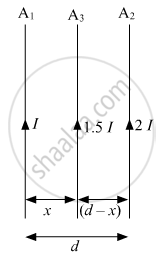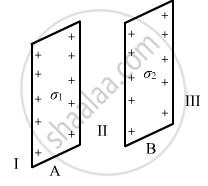Advertisements
Advertisements
Question
Answer the following question.
Two infinitely long straight wire A1 and A2 carrying currents I and 2I flowing in the same direction are kept' distance apart. Where should a third straight wire A3 carrying current 1.5 I be placed between A1 and A2 so that it experiences no net force due to A1 and A2? Does the net force acting on A3 depend on the current flowing through it?
Solution

The force per unit length between two infinitely long, parallel current-carrying wires is given by:
`F = μ_0/(2pi) (I_1I_2)/d`
where:
- I1 and I2 are the currents in the wires,
- d is the separation between them,
- μ0 is the permeability of free space.
Assigning Given Values
- A1 carries current I.
- A2 carries current 2I.
- The distance between A1 and A2 is d.
- A3 carries current 1.5I and is to be placed somewhere between A1 and A2.
For A3 to experience zero net force, the magnitudes of these forces must be equal:
F1 = F2
`μ_0/(2pi) (Ixx1.5I)/x = μ_0/(2pi) (2Ixx1.5I)/((d-x)`
`(1.5I^2)/x = (3I^2)/(d-x)`
`1/x = 2/(d-x)`
d − x = 2x
d = 3x
`x = d/3`
APPEARS IN
RELATED QUESTIONS
How does one understand this motional emf by invoking the Lorentz force acting on the free charge carriers of the conductor? Explain.
What is the magnitude of magnetic force per unit length on a wire carrying a current of 8 A and making an angle of 30° with the direction of a uniform magnetic field of 0.15 T?
Two infinitely large plane thin parallel sheets having surface charge densities σ1 and σ2 (σ1 > σ2) are shown in the figure. Write the magnitudes and directions of the net fields in the regions marked II and III.

A charged particle goes undeflected in a region containing an electric and a magnetic field. It is possible that
(a) `vecE" || "vecB , vecv" || " vec E `
(b) `vecE "is not parallel" vecB`
(c) `vecv " || " vecB but vecv "is not parallel"`
(d) `vecE" || " vecB but vecv "is not parallel"`
A long, straight wire of radius r carries a current i and is placed horizontally in a uniform magnetic field B pointing vertically upward. The current is uniformly distributed over its cross section. (a) At what points will the resultant magnetic field have maximum magnitude? What will be the maximum magnitude? (b) What will be the minimum magnitude of the resultant magnetic field?
A hypothetical magnetic field existing in a region is given by `vecB = B_0 vece` where `vece`_r denotes the unit vector along the radial direction. A circular loop of radius a, carrying a current i, is placed with its plane parallel to the x−y plane and the centre at (0, 0, d). Find the magnitude of the magnetic force acting on the loop.
Figure shows two parallel wires separated by a distance of 4.0 cm and carrying equal currents of 10 A along opposite directions. Find the magnitude of the magnetic field B at the points A1, A2, A3.

A straight, how wire carries a current of 20 A. Another wire carrying equal current is placed parallel to it. If the force acting on a length of 10 cm of the second wire is 2.0 × 10−5 N, what is the separation between them?
Two parallel wires separated by a distance of 10 cm carry currents of 10 A and 40 A along the same direction. Where should a third current by placed so that it experiences no magnetic force?
If a current I is flowing in a straight wire parallel to x-axis and magnetic field is there in the y-axis then, ______.
